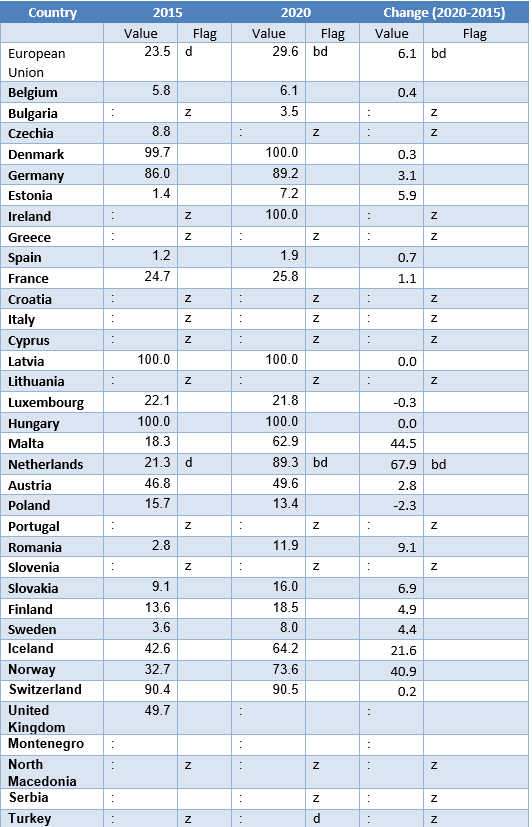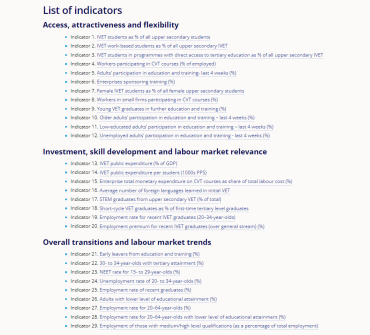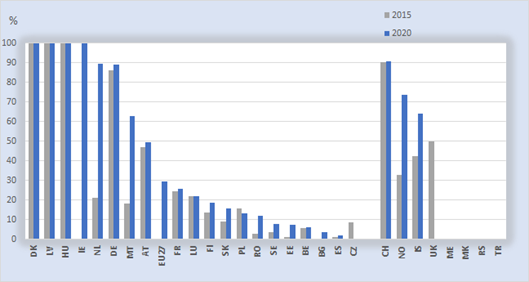Work-based learning can help transitions from education to work and develop relevant skills for the labour market. The Bruges communiqué of 2010 and the Riga conclusions of 2020 call for work-based learning to become a key feature of IVET systems. The indicator below is defined as the percentage of upper secondary VET students enrolled in combined work-and school-based programmes. In the UNESCO, OECD, Eurostat data collection on formal education (UOE), a vocational programme is work-and school-based if 25% or more of the curriculum is outside the school environment; otherwise, the programme is school-based. The indicator excludes programmes where the work-based component is 90% or more of the curriculum. Under these conditions, the work-based IVET component includes apprenticeships. Estimates of EU averages come from available country data.
Figure 2. IVET work-based students as % of all upper secondary IVET

Source: Cedefop calculations based on Eurostat data, UOE data collection on formal education systems.
Key points
Estimates are that, in 2020, in the EU, 29.6% of students in upper secondary VET were enrolled in combined work-and school-based programmes. In Denmark, Ireland, Latvia and Hungary all upper secondary VET comprised combined work-and school-based programmes. The share was also high in the Netherlands (89.3%), Germany (89.2%) and Malta (62.9%). Combined work-and school-based programmes covered almost 50% of students in upper secondary VET in Austria (49.6%), and between 10% and 30% in Romania (11.9%), Poland (13.4%), Slovakia (16.0%), Finland (18.5%), Luxembourg (21.8%), and France (25.85). The share was lower than 10% in Spain (1.9%), Bulgaria (3.5%), Belgium (6.1%). Estonia (7.2%), Sweden (8.0%).
Between 2015 and 2020, data suggest an increase in the share of enrolments in combined work-and school-based VET, in most countries for which data are available. The largest increases were Malta (44.5 percentage points) and Romania (9.1 percentage points). Increases ranging from 2.8 to 6.9 percentage points were In Austria, Germany, Sweden, Finland, Estonia, Slovakia. In the Netherlands, the share also increased substantially, but comparisons over time cannot me made, due to methodological changes, which also affected EU averages. Among non-EU countries, the share raised to 64.2% in Iceland and to 73.6% in Norway (up by 21.6 and 40.9 percentage points respectively).
In 2020, the Council Recommendation on VET and the Council Resolution for the European Education Area strategic framework, identified different target indicators on work-based learning in VET, based on new LFS data, definitions and methods. Cedefop preliminary findings, based on a pilot, and first results, indicated that work-based learning is more common than it was believed to be, although with considerable cross-country differences.
Table 2. IVET work-based students as % of all upper secondary IVET

Source: Cedefop calculations based on Eurostat data, UOE data collection on formal education systems. Notes: (d) ‘definition differs’, (b) ‘break in time series’; (z)’ not applicable. Data for the Netherlands only include enrolment in the public sector of education and cannot be properly compared over time due to methodological changes; data are not presented when they are not available and/or do not support sufficiently reliable comparisons across countries or over time.

